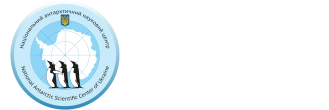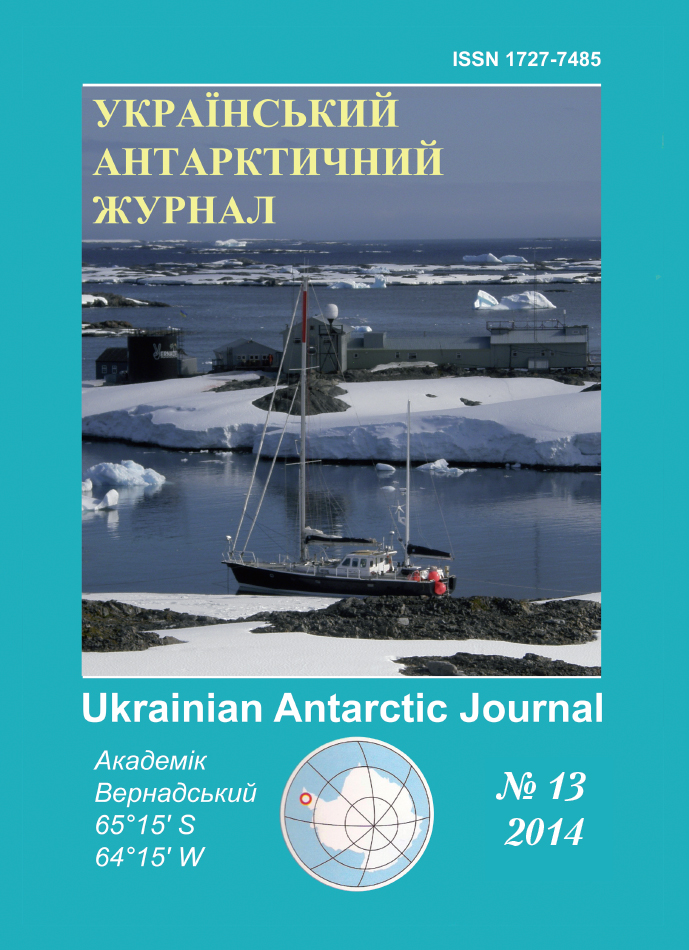Забруднення прибережної екосистеми важкими металами як показник кліматичних змін в Антарктиці
- Antarctic,
- warming of climate,
- natural pollution,
- trace metals,
- cadmium and zinc
- accumulation,
- phytoplankton,
- zooplankton,
- green macroalgae,
- ground deposits,
- krill ...Більше
Анотація
Під час попередніх досліджень у районі Української антарктичної станції (УАС) Академік Вернадський нами було виявлено підвищений вміст важких металів у донних відкладеннях та ґрунтах островів Аргентинського архіпелагу і акумуляцію важких металів різної токсичності в організмах масових видів фітозообентосу, макропланктону та риб. Високі концентрації в середовищі та в гідробіонтах кадмію і цинку – індикаторів характеру забруднення – свідчать про його природне (тектонічне) походження і про змив важких металів з материка і островів Антарктики при таненні льоду в результаті потепління в цьому регіоні клімату. Різке зниження запасів крилю (Euphausia superba Dana) – найважливішого компонента пелагічної біоти, яке спостерігається в Атлантичній частині Антарктики, асоціюється з інгібуванням відтворення рачка, ікра якого розвивається на дні мілководь, підвладних забрудненню, і свідчить про масштабність цього явища. Отримані результати дали підставу використати в якості показника тимчасових змін клімату рівні забруднення важкими металами компонентів біоти з коротким життєвим циклом, а також дані про велику кількість у водах шельфової зони личинок E. superba. Встановлено забрудненість кадмієм і цинком найважливіших компонентів планктону – фіто- й зоопланктону і двох видів зелених макроводоростей (Monostroma hariotii Gain та Cladophora repens (J. Agardh)). Виявлено часову (сезонну і міжрічну) динаміку накопичення важких металів цими компонентами прибережної екосистеми в районі УАС. У пробах зоопланктону личинок E. superba не знайдено. Це явище відзначалося під час усіх спостережень 2002–2009 рр. і свідчить про існування процесу змиву забруднювачів з суші внаслідок танення льодовиків в умовах потепління клімату в Антарктиці.
Посилання
- Voronina, N.M. (1984). E`kosistemy` pelagiali Yuzhnogo okeana. Moscow, Nauka.
- Voronina, N.M., Maslennikov, V.V., & Rat`kova, T.N. (2005). Izmeneniya struktury` antarkticheskogo planktona v mestax massovogo razvitiya sal`p [Changes in the antarctic plankton structure in places of mass development of salps]. Okeanologiya, 45(3), 393-401.
- Ermachenko, L.A., & Ermachenko, V.M. (1997). Atomno-absorbcionny`j analiz v sanitarno-gigienicheskix issledovaniyax (metodicheskoe posobie) [Atomic absorption analysis in sanitary and hygienic research (a handbook)]. Moscow.
- Ihnatiev, S.M. (2013). Zooplankton v pryberezhnii zoni UAS [Zooplankton in the shelf area of the UAS]. Transformatsiia morskoi bioty v pryberezhnii zoni Antarktyky (rehion UAS): Naukovyi zvit za dohovorom No N/25-2013kodI.1 05.00.07. 30 August 2013. – Rozdil 2.2, 13–23 (Rukopysn.).
- Maslennikov, V.V. (2003). Klimaticheskie kolebaniya i morskaya e`kosistema Antarktiki [Climatic oscillations and marine ecosystem of Antarctica]. Moscow, izd-vo VNIRO.
- Martazinova, V.F., Timofeev, V.E., & Ivanova, E.K. (2010). Sovremenny`j regional`ny`j klimat Antarkticheskogo poluostrova i stancii Akademik Vernadskij [Current regional climate of the Antarctic Peninsula and Akademik Vernadsky Station]. Ukrainian Antarctic Journal, 9, 231–248.
- Metodicheskie ukazaniya po opredeleniyu zagryaznyayushhix veshhestv v probax morskix donny`x otlozhenij i vzvesi [Methodical guidelines on pollutant determinatoin in samples of sea bottom sediments and suspension]. (1996). Moscow, Federal`naya sluzhba Rossii po gidrometeorologii i monitoringu okruzhayushhej sredy`. RD 52.10.556-95.
- Metodika vy`polneniya izmerenij massovoj koncentracii kadmiya, cinka, medi, svincza i my`sh`yaka v pishhevy`x produktax. Atomno-absorbcionny`j metod s ispol`zovaniem e`lektrotermicheskoj atomizacii [A method of high-throughput measurement of Cd, Zn, Cu, Pb & As in foodstuffs]. (1998). Severodoneczk, KNPP «Ximavtomatika-analitpribor». Analiticheskaya laboratoriya.
- Ryasinceva, N.I., & Savin, P.T. (1998). E`kologicheskie problemy` Ukrainskoj antarkticheskoj stancii Akademik Vernadskij [Environmental problems of the Ukrainian Antarctic Station Akademik Vernadsky]. Bulletin UAC, 2, 171–177.
- Ryasinceva, N.I., Savin, P.T., Sekundyak, L.Yu. et al. (1998). Nekotory`e rezul`taty` izucheniya zagryazneniya vody` i donny`x otlozhenij razlichny`x rajonov Subantarktiki [Some results of studying the waters and bottom sediments of various regions of Subantarctica]. Bulletin UAC, 2, 178–190.
- Samy`shev, E`.Z. (1991). Antarkticheskij kril` i struktura planktonnogo soobshhestva v ego areale [Antarctic krill and structure of the plankton community in its area]. AN SSSR. VGBO. Moscow, Nauka.
- Samy`shev, E`.Z. (2009). Osobennosti struktury` i funkcionirovaniya e`kosistemy` v rajone UAS «Akademik Vernadskij» [Specific features of structure and functioning of the ecosystem in the area of UAS Akademik Vernadsky]. Ukrainian Antarctic Journal, 8, 237–266.
- Samy`shev, E`.Z. (2010). K voprosu o faktorax, limitiruyushhix razmer populyacii antarkticheskogo krilya [To the problem of factors limiting the Antarctic krill poopulation size]. Mezhdunar. seminar: Klimat, resursy` Yuzhnogo okeana, ANTKOM i antarkticheskij kril` (KRAK-2010): tez. dokl. (Kyiv, 27-28 September 2010). –p. 11. Access: http://antarctica.org.ua/meetings
- Samy`shev, E`.Z., Bibik, V.A., Savich, M.S et al. (1997). K voprosu o sostoyanii populyacii antarkticheskogo krilya i pelagicheskoj e`kosistemy` v rajone morya Skotiya [To the problem of the state of Antarctic krill population and pelagic ecosystem in the Scotia Sea region]. Bulletin UAC, 1, 132–136.
- Samy`shev, E`.Z., Sokolov, B.G., & Vasilenko, V.I. (2000). Biomassa i zapasy` krilya v rajonax Atlanticheskoj chasti Antarktiki (AChA) v 1998 g. [Biomass and stocks of krill in regions of the Atlantic Part of the Antarctica (APA)]. Bulletin UAC, 3, 226–230.
- Samyshev, E.Z., Minkina, N.I., & Kopytov, Yu.P. (2013). Doslidzhennia nakoplennia vazhkykh metaliv v probakh fito- i zooplanktonu, a takozh v zelenykh makrovodorostiakh i donnykh vidkladenniakh [A study of accumulation of heavy metals in samples of phyto- and zooplankton as well as in macroalgae and bottom sediments]. Transformatsiia morskoi bioty v pryberezhnii zoni Antarktyky (rehion UAS): Naukovyi zvit za dohovorom No N/25-2013kodI.1 05.00.07 vid 30 August 2013.–Rozdil 3., p. 28–41. (Rukopysn.).
- Samy`shev, E`.Z., Minkina, N.I., Kopy`tov, Yu.P. et al. (2014). Biologicheskie i toksikologicheskie prediktory` potepleniya klimata v Antarktike. Monitoring sostoyaniya prirodnoj sredy` Antarktiki i obespechenie deyatel`nosti nacional`ny`x e`kspedicij [Biological and toxicological predictors of warming in Antarctica. Monitoring of the natural Antarctic environment and provision of national expeditions]. Materialy` I Mezhd. nauchn.-prakt. Konf. (26-29 maya 2014 g., k.p. Naroch`, Belarus`). –Minsk, E`koperspektiva. –pp. 224–230.
- Sovga, E.E. (2005). Zagryaznyayushhie veshhestva i ix svojstva v prirodnoj srede [Pollutants and their properties in the environment]. NAN Ukrainy`, Morskoj gidrofizicheskij in-t, Chernomorskoe otdelenie Moskovskogo gosudarstvennogo universiteta. Sevastopol`, E`KOSI-Gidrofizika.
- Timofeev, V.E. (2006). Prostranstvenno-vremenny`e osobennosti regional`nogo potepleniya na Antarkticheskom poluostrove [Space-time features of the regional warming on the Antarctic Peninsula]. Ukrainian Antarctic Journal, 4–5, 288–295.
- Chudinovskykh, O.S. (2013). Sklad, kilkist ta rozpodil fitoplanktonu v raioni UAS „Akademik Vernadskyi” (2007-2008 rr.) [Composition, amount and distribution of the phytoplankton in the area of UAE Akademik Vernadsky (2007-2008)]. Transformatsiia morskoi bioty v pryberezhnii zoni Antarktyky (rehion UAS): Naukovyi zvit za dohovorom No N/25-2013 kod I.1 05.00.07 vid 30 August 2013 r.–Rozdil 2.1. –p. 5–12. (Rukopysn.).
- Ahn, I.-Y., Lee, S.H., Kim, K.T. et al. (1996). Baseline heavy metal concentrations in the Antarctic clam, Laternula elliptica in Maxwell Bay, King George Island Antarctica. Marine Pollution Bulletin, 32(8/9), 592–598.
- Ahn, I.-Y., Chung, K.H., Cho, H.J. (2004). Influence of glacial runoff on baseline metal accumulation in the Antarctic limpet Nacella concinna from King George Island. Marine Pollution Bulletin, 49, 119–141.
- Antarctic climate change and the Environment. (2009). Turner, J., Bindschadler, R., Convey, P., di Prisco, G., Fahrbach, E., Gutt, J., Hodgson, D., Mayewski, P., Summerhayes, P. (Eds.). Version 1.1 25. Cambridge, Scientific Committee on Antarctic Research.
- Aranson, R.B., Thadje, S., McClintock, J.B. et al. (2011). Anthropogenic impacts on marine ecosystems in Antarctica. Annals of the New York Academy of Sciences, 1223, 82–107.
- Atkinson, A.A., Siegel, V., Pakhomov, E. et al. (2004). Long-term decline in krill stock and increase in salps within the Southern Ocean. Nature, 432, 100–103.
- Chiochiolo, A.L., Dickhut, R.M. et al. (2004). Persistent organic pollutants at the base of the Antarctic marine food web. Environ. Sci. Technol., 38, 3551–3557.
- Convey, P., Bindschadler, R., di Prisco, G. et al. (2009). Review. Antarctic climate change and the environment. Antarctic Sciences, 21(6), 541–563.
- Corsolini, S., Romeo, T., Ademollo, N. et al. (2002). POPs in key species of marine Antarctic ecosystem. Microchem. J., 73, 187–193.
- Corsolini, S., Olmastroni, S. et al. (2003). Persistent organic pollutants in stomach contents of Adelie penguins from Edmondson Point (Victoria Land, Antarctica). Antarctic Biology in a Global Context: Proc. of the VIII-th SCAR Int. Biology Symp. (27 Aug.–1 Sept. 2001, Vrije University, Amsterdam). Leiden: Backhuys Publishers, 2003. –pp. 296–300.
- Flores, H., Atkinson, A., Kawaguchi, S. et al. (2012). Impact of climate change on Antarctic krill. Marine Ecology Progress Series, 458, 1–19.
- Fryirs, K.A, Hafsteinsdуttir, E.K., Stark, S.C. et al. (2014). Metal and petroleum hydrocarbon contamination at Wilkes Station, East Antarctica. Antarctic Science, 27(2), 118-133.
- Galindo-Zaldivar, J., Maestro, A., Lopez-Martinez, J. et al. (2003). Elephant Island Recent Tectonics in the Framework of the Scotia-Antarctic-South Shetland Block Triple Junction (NE Antarctic Peninsula). Antarctica. Contribution to Global Earth Sciences: Proc. of the IX Int. Symp. of Antarctic Earth Sciences (Postdam, 2003). Springer. (pp. 271–275).
- Hanfland, C., Geibert, W., & Voge, I. (2003). Tracing Marine Processes in the Southern Ocean by Means of Naturally Occurring Radionuclides. Antarctica. Contribution to Global Earth Sciences: Proc. of the IX Int. Symp. of Antarctic Earth Sciences (Postdam, 2003). Springer. (pp. 409–413).
- Kahle, J., & Zauke, J.P. (2003). Trace metals in Antarctic copepods from the Weddell Sea (Antarctica). Chemosphere, 51, 409–417.
- Kennicutt, M.C., & Champ, M.A. (1992). Environmental awareness in Antarctica: History, problems, and future solutions. Mar. Pollut. Bull., 25(9-12), 219–340.
- Kim, S.B., Sohn, Y.K., & Choe, M.Y. (2003). The Eocene Volcanic lastic Sejong Formation, Barton Peninsula, King George Island, Antarctica: Evolving Arc Volcanism from Precursory Fire Fountaining to Vulcanian Eruptions. Antarctica. Contribution to Global Earth Sciences: Proc. of the IX Int. Symp. of Antarctic Earth Sciences (Postdam, 2003). Springer. (pp. 261–269).
- King, C.K., & Riddle, M.J. (2001). Effects of metal contaminants on the development of the common Antarctic sea urchin Sterechinus neumayeri and comparison of sensitivity with tropical and temperate echinoids. Mar. Ecol. Prog. Ser., 215, 143–154.
- Lenihan, H.S. (1992). Benthic marine pollution around McMurdo Station, Antarctica: A summary of find. Mar. Pollut. Bull., 25(9-12), 318–323.
- Lannuzel, D., Bowie, A.R., Van Der Merwe, P. et al. (2011). Distribution of dissolved and particulate metals in Antarctic sea ice. Marine Chemistry, 124(1-4), 134–146.
- Nicol, S., Croxall, J., Trathan, F. et al. (2007). Opinion. Paradigm misplaced? Antarctic marine ecosystem are affected by climate change as well as biological processes and harvesting. Antarctic Sciences, 19(3), 291–295.
- Niederlandische Liste. Atlasten Spektrum 3/95. PTS limits and levels of concern in the environment, food and human tissues. (1995). 3, 29–32. http://www.amap.no/documents.
- Negri, A., Burns, K., Boyle, S. et al. (2006). Contamination in sediments, bivalves and sponges of MacMurdo Sound, Antarctica. Environmental pollution, 143, 456–467.
- Nolting, R.F., & de Baar, H.J.W. (1994). Behaviour of nickel, copper, zinc and cadmium in the upper 300 m of a transect oin the Southern Ocean (57–62oS, 49oW). Marine Chemistry, 45, 225–242.
- Petri, G., & Zauke, G.-P. (1993). Trace metals in crustaceans in the Antarctic Ocean. Ambio, 22, 529–536.
- Runcie, J.W., & Riddle, M.J. (2004). Metal concentrations in macroalgae from East Antarctica. Marine Pollution Bulletin, 49, 1109–1126.
- Samyshev, E.Z. (2002). Antarctic krill and the structure of planktonic community in its distribution area. The 2nded. (expand.) Moscow, Nauka. –168 p. –(Acad. of Sci. of the USSR. All-Union Hydrobiol. Soc.) +the recently included Chapter VI. –Sevastopol, ECOSEA-Hydrophysics, 2002. –268 p.
- Samyshev, E.Z. (2011a). The structure and functioning of Antarctic marine coastal ecosystems in the conditions of natural and anthropogenic contaminations. Morskoj e`kologicheskij zhurnal, 10(2), 3–25.
- Samyshev, E.Z. (2011b). The structure and functioning of marine ecosystem in Argentine Islands waters. Reports of Sci. Committee of CCAMLR, Working Group of Ecological Monitoring and Management (SC-CCAMLR/WG-EMM-11/5), Busan (S. Corea), 27 June 2011, 2.1, 1–5.
- Vodopivez, C., Mac Cormack, W.P., Villaamil, E. et al. (2008).. Evidence of pollution with hydrocarbons and heavy metals in the surrounding of Jubany Station. Berichte zur Polar und Meeresforschung. –V. 571 -2008. Report on POLAR AND Mar.Res. The Antarctic ecosystem of Potter Cove, King George Island (Isla 25 de Mayo). Synopsis of research performed 1999–2006 at the Dallmann Lab. and Jubany Station (C. Wiencke, G.A. Ferreyra, D. Abeleand S. Marenssi -Eds.). –pp.357–364.

